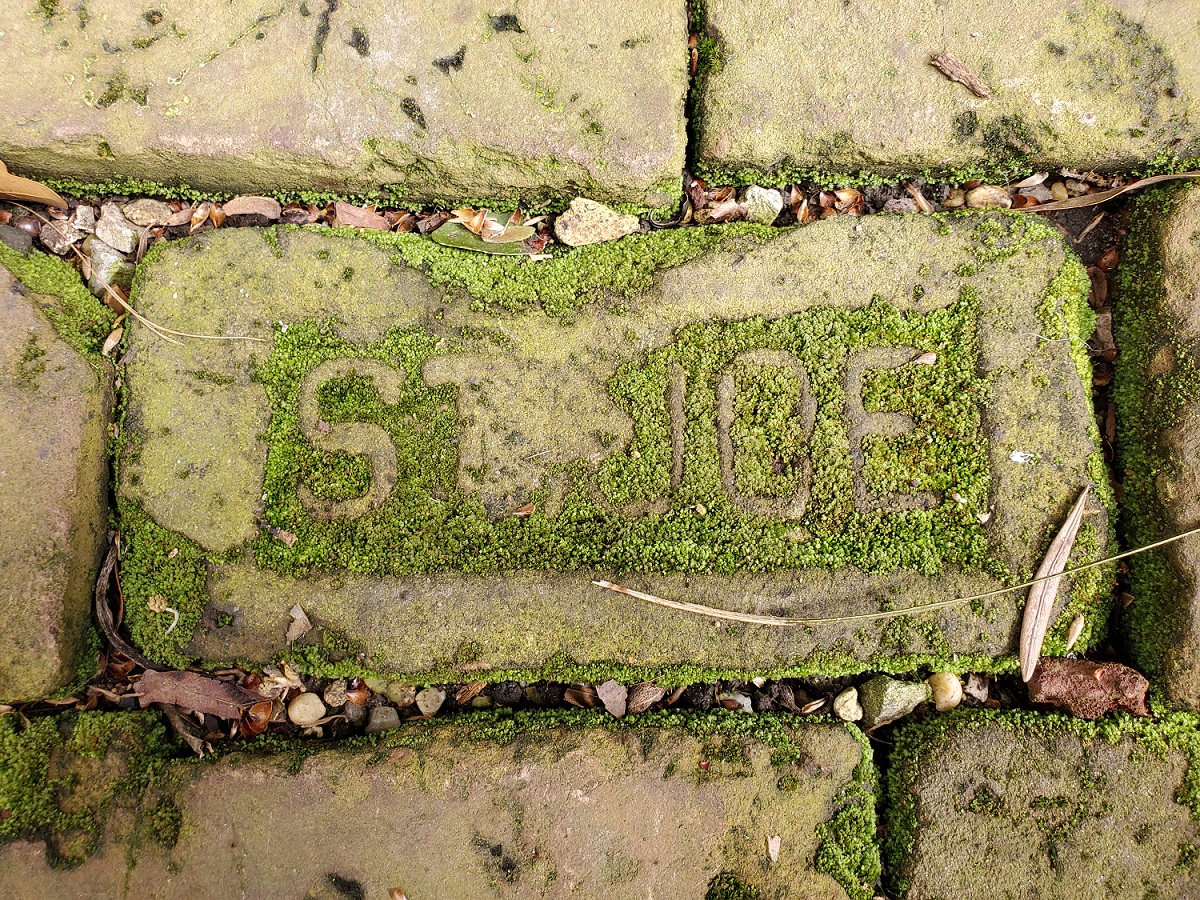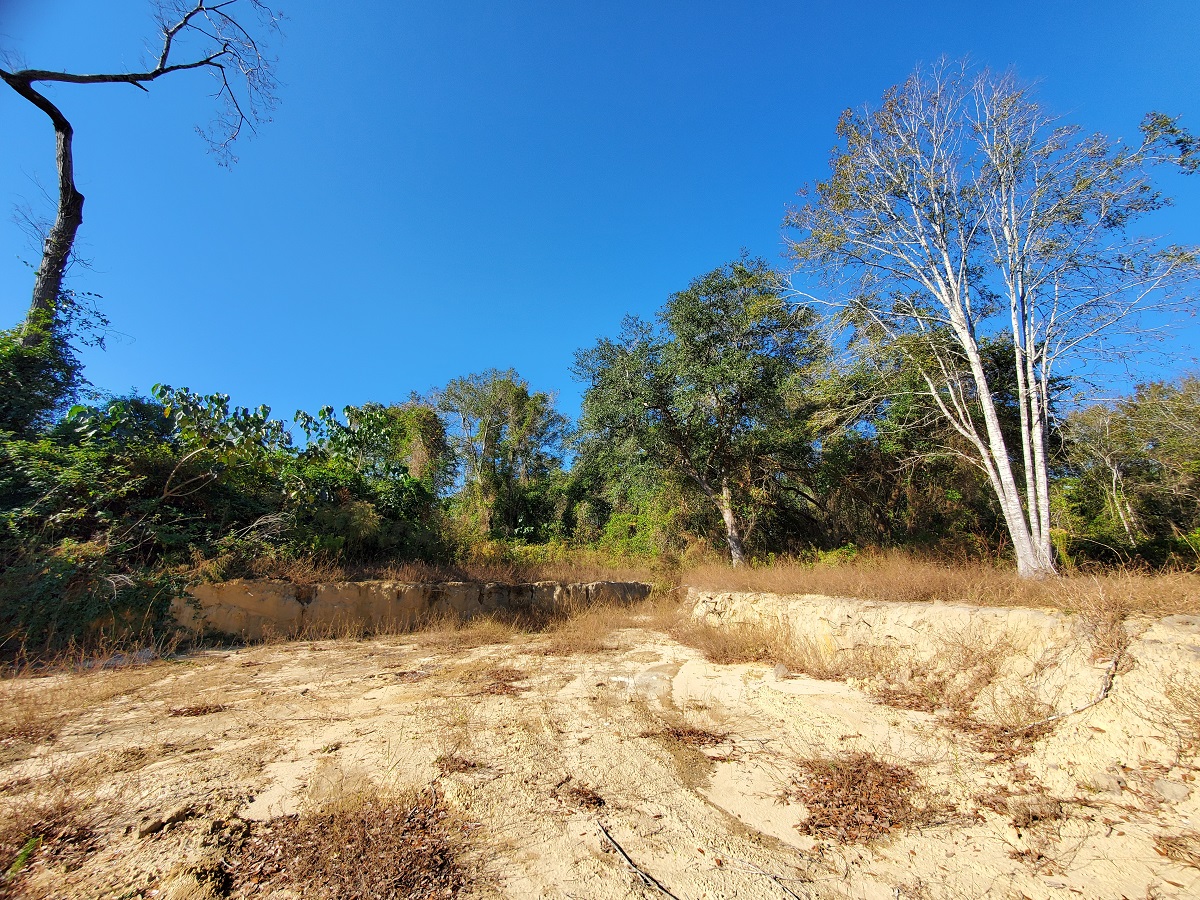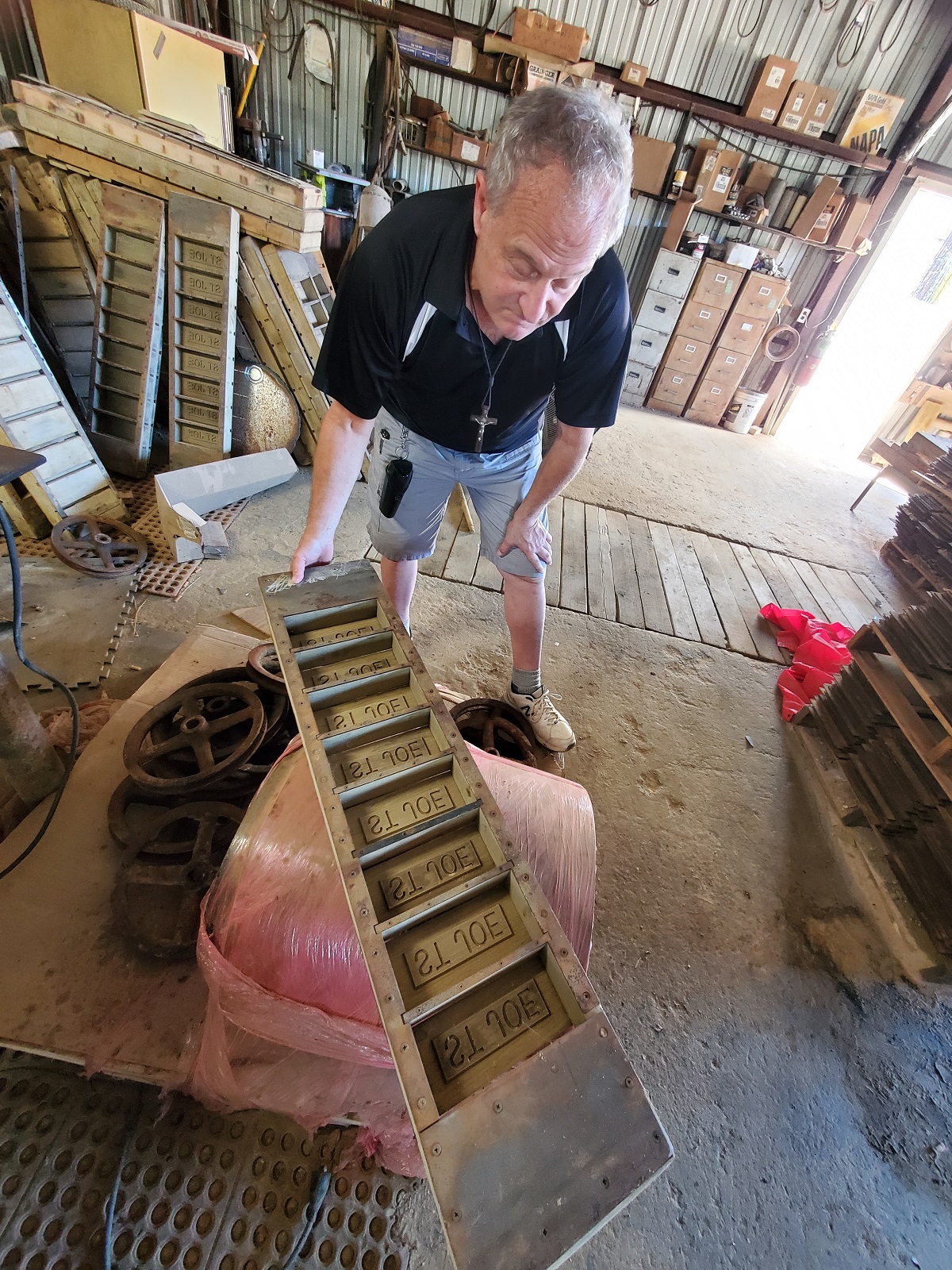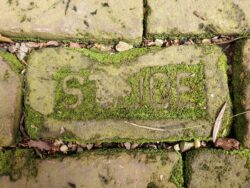Spring 2023
The St. Joe Brick Yard
Hiding in plain sight
Published: February 28, 2023
Last Updated: June 1, 2023

Photo by Benjamin Morris
A Joe in New Orleans hosts moss (courtesy of Randy Spitler).
Sweeping off the dirt, I wondered where they had all come from—despite the fact that the two dozen bricks I had unearthed were all saying their name.
Though traces of this part of its past can be tricky to find, the north shore of Lake Pontchartrain was once a haven for brickyards. With abundant natural clay and easy access to water, French artisans arrived in this area in the 1700s to ply their trade, taking advantage of rich soils laid down in the floodplains over thousands of years. These craftsmen enjoyed a vibrant market in the nearby settlement of New Orleans, where demand soared after the two Vieux Carré fires of the late 1700s, and its Spanish governors mandated brick instead of wood for all new construction. From their earliest years, brickmakers in St. Tammany Parish were laying the foundation for generations of industry to come—literally and figuratively.For most of the 1800s, brickmaking often took place in small kilns or ovens located on private land, particularly along riverine communities and plantations. With advances in technology such as steam power, rail distribution, and cast iron, however, late in that century brickmaking entered its golden age, with an influx of new purveyors arriving shortly after Slidell was founded circa 1882. Best-known among them in St. Tammany Parish was Fritz Salmen, a Swiss immigrant whose expansive Salmen Brick and Lumber Company, founded in 1886, almost single-handedly gave shape to much of early Slidell. Competing with Salmen in those early years were larger operators such as the Slidell Brickworks as well as smaller, independent brickmakers, in particular a man whose brickmaking business would fail but whose name would endure longer than he could have imagined.

The brickyard. Photo by Benjamin Morris.
Comparatively little today is known about Joseph McCarron, except that he was an Irish immigrant to the area, a member of a prominent Catholic family based in New Orleans, whose devotion to his faith and to his community earned him the affectionate nickname of Saint Joe. Also known is that his spiritual acumen somewhat exceeded his business acumen, given that four years after McCarron incorporated his brickworks in 1891, he was forced to sell the company for $15,000 to cover his debts. Purchasing McCarron’s plant was another European immigrant, German-born Peter W. Schneider, who in a nod to the brickyard’s founder left McCarron’s nickname stamped upon his work.
Schneider was no stranger to the craft; prior to moving to St. Tammany Parish, he had sold his stake in a brickyard upriver in St. Rose (St. Charles Parish) to his partner, and brought his family and his knowledge east with him. At some point in those early years of his ownership—though exactly when remains unclear—the moniker of “old Saint Joe’s brick yard” calcified into the St. Joe Brick Yard, and the name stuck. In companies as in countries, empires rise and empires fall: though Fritz Salmen had dominated Slidell’s industrial landscape at the turn of the century, Schneider took the long view against his competitor and began training his five sons in the business. He did not live to witness it, passing away in 1926—but in 1931, in the early years of the Great Depression, Salmen was forced to sell the brickmaking portion of his once-grand empire to the Schneiders, three years before his own death.
Today, those same Schneiders—now great-grandsons and great-great-grandsons—are still making bricks by hand, just as Peter I was in 1895.
Modern brick collectors call it “the bug”: once bitten, the condition is both acute and incurable. Unaware that I had been infected, I was nevertheless suffering from its symptoms. Down every sidewalk in New Orleans, I began to walk like the opposite of the proverbial tourist: neck crooked, eyes down, scanning each clay face for blocks at a time. No matter where I was in town—visiting friends, getting a haircut, doing construction—a brick patio or garden feature would consume my gaze. Setting up a table saw on a carpentry job on North Frenchmen Street, I found the largest domestic collection of Joes I had yet seen, easily five hundred bricks, all face up in the sun. Where’d you find them? I inquired eagerly, nail gun in hand. The homeowner shrugged—picked them up in Baton Rouge years ago, he said, had known they were historic, had paid four figures for the lot, but for the life of him he couldn’t remember where.Try as I might, I couldn’t be annoyed; he’d been bitten too, the poor soul, and there we were, two doomed patients on the same bleak ward.
Trained as an archaeologist, I tend to assume that the antiquities I unearth from the soil don’t have web sites attached to them, much less phone numbers. Curious after these recent hauls, however, I looked up whether St. Joe still exists, and found not only an address less than an hour away, but a human voice on the other end of the telephone line inviting me to come and visit.
One crisp October morning, then, I drove up to Pearl River to meet Chris Schneider for a three-hour tour of the yard. Affable, generous, and knowledgeable, Chris could not be more down to earth: one of Peter I’s great-grandsons, he got his start as a teenager driving dump trucks loaded with dirt back and forth to the yard, and over fifty years has worked in nearly every area of operations at St. Joe.
Our first stop was one of the active clay pits, just off Highway 11 on an unmarked cut-through, just like you’d find heading to your uncle’s deer camp. We drove up over a rise, then the road abruptly fell off to reveal a wide-open expanse where the ground has been scraped as clean as a face shaven with a new blade. “We only take off the top layer of dirt,” Chris explained, “three to five feet at most.” The cut line was clearly visible. The few trees that remain—mostly pin oaks and the occasional gum—are left undisturbed so that the leaf-fall can regenerate the soils underneath them. They looked like monarchs sitting on dirt thrones, ruling over empty plains.

A harvested clay pit. Photo by Benjamin Morris.
To call it a pit is slightly misleading, as the area resembles an open depression more than a quarry spiraling downwards or a bottomless hole. Terminology aside, however, these fortyish-acre plots are where the raw clay for the bricks is cut and drawn. Of the 1,200 or so acres that Peter I first bought, different parcels have been harvested, sold off to developers or other industries (such as gravel), and even expropriated by eminent domain—you wouldn’t know it, but anyone passing Rooms To Go on Interstate 59 north of Slidell is driving on former St. Joe land. At present the company still has plenty to draw from; rather than quantity, their concern is quality: the type and composition of the soil.
I asked Chris how they test the parcels, to see whether the clay in a given area is suitable for molding and firing. With a gleam in his eye, he grinned. “I stick a shovel in the ground and taste it,” he said, with a nonchalance that would make any Louisiana State University pedologist proud. (Soil scientists are famous for tasting dirt to check for acidity and grit; the refinement of the human palate takes many forms.) Scattered across the Pearl River floodplain, the St. Joe pits vary widely in makeup, from “sandy” clay to “dirty” clay, the two most important types for brickmaking. One thing that all the area soils have in common, though, is the presence of iron pyrite, fool’s gold, that when fired gives the Joes their distinctive speckled look, difficult to reproduce and cherished by architects the region over.
Chris took me to the very back of the brickyard, where he showed me what he called a “baby pit”—one he cleared shortly after Katrina, and which he had just begun to revisit. In general, most pits take about twenty or thirty years to regenerate before they’re ready to be harvested; frequently, St. Joe will throw rejects that have not yet been fired (“green” bricks) back into these pits to fatten them up, make use of waste, and speed up the process. I asked Chris if there’s a map of the pits in the area, some sort of spreadsheet or GIS plot by which they track which pits are ready and which are still maturing. “Sure,” he said, shrugging. “In my head.”
Luckily for me, the main brick press was down for the moment, undergoing maintenance, so we were able to clamber all the way down the production line. First we started in the dried clay barn, where mountains of sandy clay and dirty clay loomed over us, piled high—in the low light, with their distant ridges and scree falls, they looked eerily like Frank Hurley’s early photographs of Antarctic glaciers, if ice had been swapped out for dirt.
Here more than anywhere, however, the metaphors for baking came to mind. To arrive at the correct blend of soils for the brick, Chris uses a front-end loader to mix the sandy and dirty clays together, feeling for moisture and texture the way a baker might whisk two types of flour together for bread. This blend is then fed along a series of conveyor belts not unlike those at Café du Monde, sifting out the debris and adding water, until the wet mixture—the dough, we might say—reaches the brick press further down the line. This exceptional machine, made in 1955 out of Lancaster, Pennsylvania, cast iron, presses the mixture into the wooden molds where the St. Joe stamp waits, lettered in reverse. Each standard mold holds eight bricks and is sprinkled with fine masonry sand (think nonstick cooking spray) to help the bricks pop back out clean and whole, with their iconic stamp now legible. Once pressed, these loaves—er, bricks—are then collected, stacked, and left to dry for two days before they’re ready to go into the oven.

Chris Schneider holds a brick mold. Photo by Benjamin Morris.
Before we visited the kiln, Chris showed me the many different molds that St. Joe has used over the years; though the standard brick measures 3 5/8 inches wide, 2 1/4 inches tall, and 8 inches long, architects and designers occasionally request bricks made with slightly different proportions or features, such as angled ends or a curved length used for columns or archways. The molds, made of red maple by J. B. Crowell and Son of upstate New York, last about a year at most before they have to be replaced, but a single mold can easily produce thousands of bricks before it is retired.
As we walked through the yard, Chris pointed to the cubes stacked high into the air. Each cube holds between 544 and 640 bricks; arrayed in towers around the kilns they form a kind of labyrinth. Yet at the heart of this maze is not a minotaur but a cavernous structure whose circular walls rise to a cupola at its peak. Fed by twelve natural gas lines, this monster literally breathes fire: the hot air rises to the ceiling, then is drawn back through the bricks by an exhaust system in the center of the room. Built in the late 1960s, this “beehive” style of kiln—one of several on site—was an innovation over the rectangular scove kilns of Peter I’s day: though the curvature of the walls prevents the maximal use of interior space, it enables more flexibility in temperature control, resulting in a wider variety of bricks that can be fired.

Chris Schneider in the kiln. Photo by Benjamin Morris.
But back to the baking metaphors: when fired, as the wet “dough” hardens into a “loaf” of brick, the two factors that determine the nature of the finished product are time and temperature. By controlling the duration and intensity of a burn, St. Joe can produce an astonishing variety of brick colors all from the same raw material. “Every brick you see in the yard,” Chris told me, “came from the exact same clay in the beginning.” With such a range of creamy tans, soft peaches, rich vermilions, and tranquil neutrals, such a claim is almost too difficult to believe—but here the decades of family expertise rear their head. Once the sliding doors are closed and the bricks are baking at temperatures up to 2500°F, Chris can peek through a peephole barely four inches wide and, judging by the thermal distortion in the air and the changes in the gradient of the stacked bricks, know when to kick up the heat, when to scorch the bricks with a sudden fireball (he called this a “smudge”), or when to ease off the burn.
Under such extreme conditions, do bricks break? Absolutely—the failure rates for different types and shapes of brick are well known at St. Joe, but the resulting fragments, known as brickbats, yield a cheap and handy building material in their own right, used for everything from shoring up levee walls to laying road base for highways. But with this many years of experience behind the process, the high success rates mean finished bricks nevertheless emerge from the kilns in the thousands, just as they have since Peter I first opened shop—one account notes that by 1905, with fifty to seventy-five employees, three kilns, and just one press, Peter was already producing 30,000 bricks per day. Sometime in the 1970s, Chris told me, brick number one billion entered the yard; currently, they’re somewhere around brick number 1.6 billion, maybe 1.7 billion. By the end of this decade, St. Joe may well have produced its second billionth brick.
Allow the baking metaphors one last time: no matter how you slice it, that’s a lot of bread.
One of the ironies of the St. Joe story is the fact that their bricks are found all across Louisiana, but you’d never know it. Not only are countless Joes produced without a stamp, but sometimes those that are stamped are set with their faces hidden: I recently walked down a driveway in New Orleans’s Bayou St. John area made of hundreds of Joes, with only a dozen or so laid face-up. Find a wall with one Joe, and you’ve often found a wall with all Joes. Willie White, an architectural salvager in New Orleans, told me that he had recently torn down a gym on Magazine Street built out of thousands of Joes, but no one knew they were there until it was demolished.Conversely, if you do know where to look, Joes can be found from one end of the Gulf South to the other. Not only do they form a major portion of the campus of Rice University in Houston, which has a longstanding contract for a variety of standard and custom bricks, but decades ago the yard got a call from Fort Jefferson in the Dry Tortugas, down in the Florida Keys. With the walls of this nineteenth-century fort in dire need of repair, park authorities asked St. Joe to create a custom brick to match the size, shape, and color of the original—a request that resulted in thousands of bricks being mixed, molded, fired, and shipped over water and air.
Taken by the hunt, captivated by where they turn up, I kept discovering new batches of Joes around town: a lone one here, a handful there. Then one day an old friend of mine, a carpenter who specializes in whole-house renovations, called and said he had something worth looking at. I headed over to Rousselin Street in New Orleans’s Seventh Ward, where Eliot had pulled down a chimney stack in the shotgun he was gutting. Every single brick was a Joe, all the way down to the dirt. The brickbats laid in a pile outside the house, but a good many were intact, especially those from underneath the house—the humidity had loosened the mortar to where each brick popped clean off. I grabbed my hammer and chisel and worked my way down, netting nearly a hundred, already planning their new layout in my backyard, right next to where I’d found my first.
When discussing numbers in the billions, one might think that the years ahead offer smooth sailing, but the Schneider family takes nothing for granted. Doing business of any kind in southeast Louisiana poses numerous challenges, high among them the increasingly unstable climate. St. Joe has been fortunate to weather the hurricanes of the last decades with only moderate damage (mostly to their roofs in the yard), usually getting back up to speed within days. The pits, too, naturally recover after pulses from floods, absorbing and discharging water as normal, and, given the regenerative capacities of the soils, Chris estimated they’re sitting on enough raw clay to last them the next fifty years.
A nameplate on the brick press. Photo by Benjamin Morris.
Certainly a major storm remains a threat, but of far greater concern than their environmental challenges are their economic ones. St. Joe has more than enough land to supply their bricks, and more than enough demand to sell them. What they don’t have are the workers to make them. At the outset of the pandemic, much of their workforce walked off the yard and never returned, leading to major interruptions in the yard’s ability to fill the orders they had already received. Production backlogs are not unusual in this area of industry, but this backlog, compounded by the maintenance work on the press, is unlike any in living memory. “It’s simple: if we could make more bricks,” Chris told me, “we could sell more.” Granted, many businesses nationwide are still struggling to recover from workforce shortages, but even with the prospect of living wages and a long-term career for prospective hires, St. Joe is still operating on a skeleton crew—many weekends nowadays, most workers on the yard are Schneiders, including Pete III (Chris’s brother and the current president of the company), and Pete IV, Pete III’s son and Chris’s nephew. Once again, as in the earliest years of the business, the situation is all hands on deck.
But the Schneiders aren’t worried: they’ve faced challenges and downturns before, and if it means that clients have to wait a little longer (or a lot longer) to get their bricks, it’s because those bricks are still being made in a process that has lasted virtually unchanged over 130 years, with historic, intricate machines they still repair by hand, just as their great-grandfather did. Dreams of new equipment or specialized bricks or expanded facilities are still on the horizon, Chris said, but staying true to the process takes priority above all. Ultimately, the one thing that can always be said of St. Joe is that its future is built squarely on the foundation of its past.
As I got ready to leave, Pete III joined us at the entrance to the yard, and the Schneider brothers pressed upon me a priceless gift, one that I was almost too embarrassed to accept. They handed me what to an untrained eye would be just another dusty old brick, but then Chris pointed to its stamp, still visible after all these years: PWS, the initials of his great-grandfather, Peter W. Schneider. This brick, he told me, dates to the late 1890s, and came from the same “baby pit” he showed me earlier that day—one of the very first pits that Peter I dug out after purchasing the yard from old Saint Joe McCarron himself, before the yard even gained its new name.I tried to refuse, but the Schneiders insisted, and waved cheerfully as they headed back off to the yard. Even now, as it sits in pride of place on my mantel, I can scarcely believe it—especially once the truth of the matter becomes clear. All this time, for all these many months, I’d thought that I was the one out searching for St. Joe bricks—when all the while, I now realize, the bricks were out searching for me.
A writer and researcher, Benjamin Morris, PhD is the author of Ecotone (Antenna/Press Street Press), a poetry collection inspired by the coastal forests of Louisiana.
